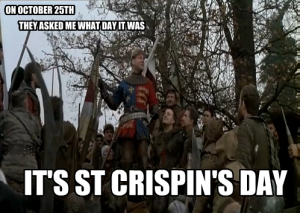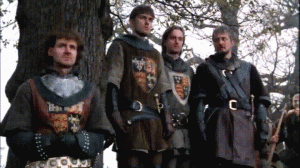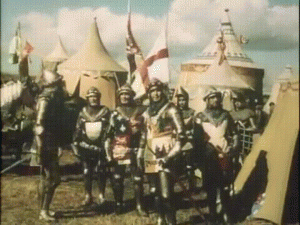Kenneth Branagh and Lawrence Olivier’s respective versions of Henry V take very stylistically different approaches to Act 4 Scene 3. The scenery’s atmosphere is immensely different between the two films, Branagh shot with the sky overcast, the land is soil, the trees surrounding them are barren of leaves, in front of the few soldiers lie barricades. This is in stark contrast to Lawrence Olivier’s opening scene. The sky is blue and beating down on the soldiers, beneath their feet is grass, and between the dozens of tents surrounding the campsite lie legions of soldiers. Branagh appears to try to create a greater feeling of hopelessness; the King’s army has all odds against them. In contrast Olivier chooses scenery that sets up a glorious victory. This is due to Olivier’s decision to contrast England’s social climate during World War II, the movie was meant to rouse the troops. Branagh’s version however was filmed in a time of peace but still maintains a dreary atmosphere. Samuel Crowl’s Shakespeare and Film supports this contrast of the two films “Branagh’s approach fit his skeptical post Vietnam and Falklands war historical moment as appropriately as appropriately as Oliver’s had fit the heroism of the World War II era” (Crowl, 17).

A moment that encapsulates the distinctly different scenery is the opening scene in which Henry V’s companions wait anxiously for the King to arrive.
“Gloucester: Where is the king?
Bedford: The king himself is rode to view their battle.
Westmoreland: Of fighting men they have full three score thousand.
Exeter: There’s five to one; besides, they all are fresh.
Salisbury: God’s arm strike with us! ‘Tis a fearful odds. “(Shakespeare Act 4 scene 3, lines 1-5).
![]()

Interestingly Branagh chooses to move the conversation to a different group of soldier’s part way through the dialogue, this would infer a widespread fear and hopelessness;

In contrast to Olivier’s version in which the conversation is isolated between that small group of soldiers. The actors in Branagh have a much more sullen tone, filled with fear; while Olivier has the actors conversing in an impartial tone.
Both films slightly adapt the text from this scene. Both directors deemed lines 24 of 33 to be extraneous but Branagh cut significantly more original text. While Olivier cut only 22 of 129 lines, Branagh cut 48 of 129 lines. Olivier’s method was likely a result of his era; he sticks with the text very closely while only trimming a few lines. Branagh’s version of the play is clearly aimed at a more modern and mainstream audience; it trims quite a bit more text to streamline and push the plot forward. While it may seem that Branagh cut a significant portion of the text, it must be taken into account that he is a victim of his era and therefore must aim for a shorter screen time. In Russell Jackson’s text From Play-script to Screen Play “His [Syd Field] definition of ‘the real dynamic of good screenwriting’ offers an encapsulated definition of successful mainstream work: ‘strong and active characters, combined with a unique, stylized visual narrative that constantly moves the story forward’. Aiming for the ‘ideal’ running time of less than two hours, most Shakespeare films have used no more than 25–30 per cent of the original text”(Russell Jackson, 17). This is everything that Branagh aims for. His scene is very fluid, while to a modern critic Olivier’s version is much more drawn out. An example of this trimming is Branagh cutting lines 93-107. This is an interesting digression, however it does not move the plot forward and is repeated later in the same section. Earlier in the script it explains the soldiers as outnumbered five to one inferring that the battle would be a difficult one. Lines like “A many of our bodies shall no doubt
Find native graves; upon the which, I trust,
Shall witness live in brass of this day’s work:” (Shakespeare 95-97) are extraneous in the sense that they present no new information. In turn these lines must be removed because they do not fit the modern criteria for a successful mainstream work.
Works Cited
Jackson, Russell. “From Play-script to Screenplay.” The Cambridge Companion to Shakespeare on Film (n.d.): 17. Web.
Crowl, Samuel. Shakespeare and Film: A Norton Guide. New York: W.W. Norton, 2008. Print.
Shakespeare, William, and T. W. Craik. King Henry V. New York: Bloomsbury, 1995. Print.
Leave a Reply
You must be logged in to post a comment.